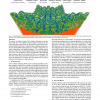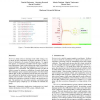118
Voted
APVIS
2011
14 years 24 days ago
2011
We present the results of a study comparing five directed-edge representations for use in 2D, screen-based node-link diagrams. The goal of this work is to extend the understandin...
143
click to vote
APVIS
2011
14 years 24 days ago
2011
Graphs are often used to encapsulate relationships between objects. Node-link diagrams, commonly used to visualize graphs, suffer from visual clutter on large graphs. Edge bundlin...
178
Voted
APVIS
2011
14 years 24 days ago
2011
Many data sets exist that contain both geospatial and temporal elements. Within such data sets, it can be difficult to determine how the data have changed over spatial and tempor...
116
Voted
APVIS
2011
14 years 24 days ago
2011
Robust analysis of vector fields has been established as an important tool for deriving insights from the complex systems these fields model. Many analysis techniques rely on co...
126
click to vote
APVIS
2011
14 years 24 days ago
2011
Maps offer a familiar way to present geographic data (continents, countries), and additional information (topography, geology), can be displayed with the help of contours and heat...
141
Voted
APVIS
2011
14 years 24 days ago
2011
Visualization of flow fields with geometric primitives is often challenging due to occlusion that is inevitably introduced by 3D streamlines. In this paper, we present a novel v...
APVIS
2011
14 years 24 days ago
2011
134
Voted
APVIS
2011
14 years 24 days ago
2011
We present an efficient method for volume rendering by raycasting on the CPU. We employ coherent packet traversal of an implicit bounding volume hierarchy, heuristically pruned u...
138
click to vote
APVIS
2011
2011
Loose capacity-constrained representatives for the qualitative visual analysis in molecular dynamics
14 years 24 days ago
Molecular dynamics is a widely used simulation technique to investigate material properties and structural changes under external forces. The availability of more powerful cluster...
166
Voted
APVIS
2011
14 years 24 days ago
2011
NETSPEAK helps writers in choosing words while writing a text. It checks for the commonness of phrases and allows for the retrieval of alternatives by means of wildcard queries. T...






